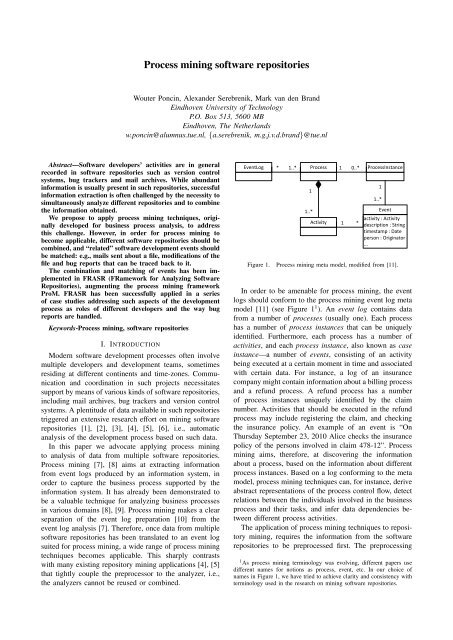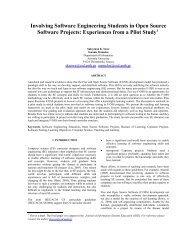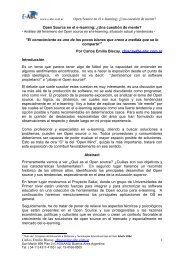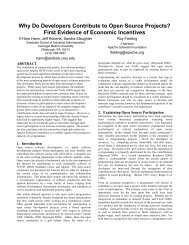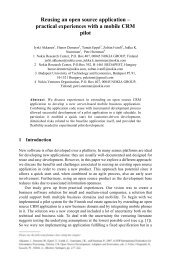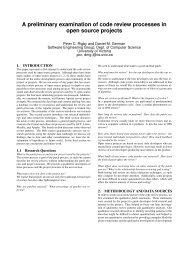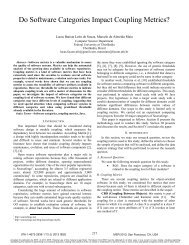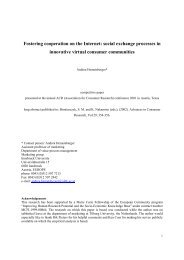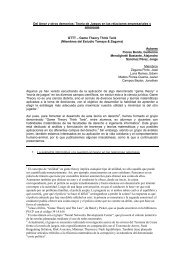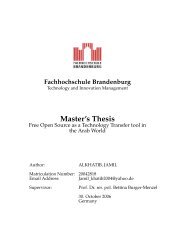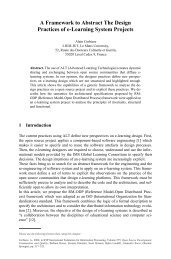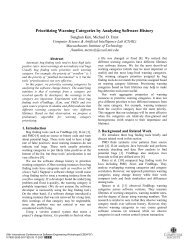Process mining software repositories - FLOSShub
Process mining software repositories - FLOSShub
Process mining software repositories - FLOSShub
You also want an ePaper? Increase the reach of your titles
YUMPU automatically turns print PDFs into web optimized ePapers that Google loves.
and evolution of the system should be significant.Therefore, we require such a developer to have morerevisions in the version control system than average(of all the developers having events in the versioncontrol system). Moreover, core members must haveadded files to and modified files in the version controlsystem.• Active developers regularly contribute new featuresand fix bugs, i.e., during their activity period theyshould have Ticket-closed, VCS: A and VCS: Mevents. We interpret “regularly” as at least one eventevery month. Furthermore, to distinguish active developersand core members we require the continuousactivity period of active developers to be shorter thanthirty-six months.• Peripheral developer are those with sporadic orirregular contribution to the system functionality. Tocharacterize these developers we require them to haveboth VCS: A and VCS: M events, but no longerrequire the events to be present every month.• Bug fixer is a developer that fixes bugs discoveredeither by herself or by a different developer. Thismeans that the bug fixers should have Ticket-closedand VCS: M events, and should not belong to theother categories.• Bug reporter is an open-source counterpart of atester. Bug reporters discover bugs and report them,but do not modify the code. Bug reporting occurseither using a bug tracker or a mailing list: samplesof the mailing list messages in a number of projectshave been inspected, confirming that the mailing listsare indeed often used for reporting bugs. Hence, bugreporters have Ticket-created events or Mail threadcreated, but no events related to version control.• Reader goes beyond using the system and inspectsthe code to understand how the system works.• Passive user is attracted by the functionality ofan open source system, but does not attempt tocontribute to it.As activities of readers and passive users are often notreflected in <strong>software</strong> <strong>repositories</strong>, we do not consider theseclasses further. Indeed, the only information availableabout the behavior of passive users is the number oftimes the executables were downloaded, but as registrationis often not a prerequisite for downloading wecannot distinguish between different passive users. Similarly,registration-free access to the source code does notallow to distinguish between different readers. Therefore,we only consider the categories: bug reporter, bug fixer,peripheral developer, active developer, core member andproject leader.2) System under investigation: We have chosen tostudy aMSN, a free and open source instant messagingapplication, clone of Windows Live Messenger. UnlikeWindows Live Messenger, aMSN supports Macintoshand UNIX/Linux in addition to the Windowsplatform. At the moment of writing aMSN has beendownloaded more than 38 million times, making it 20thmost popular SourceForge project of all times. To analyseaMSN we have considered seven bug <strong>repositories</strong>(bugs, feature requests, patches, plugins, skins, supportrequests and translations), three mail archives (commits,devel and lang) and one Subversion repository locatedat https://amsn.svn.sourceforge.net/svnroot/amsn/. We have focused on the period fromFebruary 26, 2002 until July 09, 2010. In total, the<strong>repositories</strong> contained 3137 bug reports, 34947 mail messagesand 12062 revisions. The aMSN project also has adiscussion forum. However, the data of this forum cannotbe used in the current implementation of FRASR.The data from the <strong>software</strong> <strong>repositories</strong> has been exportedusing the developer case and the data source specificbinding for each data source. The developer matchinghas been calculated automatically using the simple heuristicsmentioned in Section II-C. Furthermore, we assumethat the time stamps are synchronous, i.e., when timestamps from both <strong>repositories</strong> are equal, the points in ‘realtime’ they were recorded, do not differ significantly.3) Results: Using the exported log in combination withthe ProM Dotted Chart visualization and a spreadsheetapplication, the developers were assigned to one of theavailable roles. Figure 4 presents a part of a DottedChart visualization, used in the classification. Green dotscorrespond to mail events such as Mail thread created andMail reply, black to Ticket-created, red to other bug trackerevents, blue to addition of files in the version controlsystem, and finally white to other events of the versioncontrol system (modifications, deletions and renames). Thesize of dots represents a number of events occurring inthe same week and color mixture corresponds to eventsof different kinds occurring in the same week.By inspecting Figure 4 we clearly see that the developerin the first line is represented by a sequence of overlappingwhite, red and blue dots, starting at the very beginningof the project. According to the classification rules abovethis developer (Alvaro J. Iradier Muro/airadier 2 ) will beclassified as the project leader. Furthermore, we observethat some developers are represented by long sequences ofoverlapping dots, as is, for instance, the case for AlaouiYouness/kakaroto and Boris Faure/billiob. These developersare core members of the project. Shorter sequences representactive developers, such as Arieh Schneier/lio lionand Tom Jenkins/bluetit. Finally, disconnected dots arecharacteristic for the sporadic activity of peripheral developers.This is, for instance, the case for Harry Vennik/thaven.Visual inspection of Figure 4 provides for qualitativeresults. Additional quantitative results have been obtainedby exporting the relation between the developers andactivities, expressed by a so called ProM “originatorby activity matrix”, to the spreadsheet application andperforming simple counting. In this way, out of 1725developers we have identified 1443 bug reporters, 3 bug2 The developer names are derived from the information of the associateddeveloper aliases. This includes for example a username and aname associated to an email address.
Figure 4. Dotted Chart visualization of the top-15 developers of aMSN, sorted by number of events. Color legend: Green: Mail thread created andMail reply. Black: Ticket-created. Red: Ticket-closed, Ticket-commented, Ticket-reopened. Blue: VCS: A (file added). White: VCS: M (file modified),VCS: D (file deleted) and VCS: R (file renamed)fixers, 29 periferal developers, 6 active developers, 7 coremembers and 3 project leaders. Moreover, 234 developerscannot be classified according the rules above: these are,e.g., developers having only Ticket-commented or Mailreply events (6 max), anonymous developers and theSourceForge robot commenting on and closing tickets.4) Conclusions: The case study has revealed a numberof shortcomings of the classification of [17]. First of all,the classification considers the entire development processas a whole, while developers clearly interleave periodsof high and low activity (see, e.g., the behavior of KarelDemeyer/scapor in Figure 4). To address this problem, theclassification can be refined to take only shorter periodsof time into account. The refined classification can befurther supported by the filtering capabilities of FRASR(Section III). Furthermore, we have observed that suchclassification criteria as “responsibility for vision andoverall direction of the project” are difficult to formalize,and therefore, to assess objectively.Compared to the general structure of open source <strong>software</strong>communities (as presented in [17]), our results exhibita relatively low number of bug fixers. We conjecturethat access to the Subversion repository is granted only torelatively active project members, i.e., bugs are fixed byproject members classified as peripheral developers.From the methodological point of view this case studyillustrates that <strong>software</strong> engineering questions that cannotbe split to sub-questions pertaining to individual <strong>repositories</strong>can be answered using FRASR and ProM combinationdue to the ability of FRASR to combine informationcoming from different <strong>software</strong> <strong>repositories</strong>. Identificationof bug fixers provides an example of such a <strong>software</strong>engineering question.Validity of the conclusions above could have beenaffected by a number of threats. Construction validitypertains to the way the study has been conducted: wehave, for instance, not considered the discussion forumof aMSN that might have been used for bug reporting.In this way we could have misclassified some developers.To compensate for this we did not distinguish betweendifferent kinds of mail archives and considered, e.g., the“translations” mail archive as relevant for bug reporting.As we do not aim at generalizing our conclusions toadditional developer classification approaches or <strong>software</strong>systems, no threats to external validity are present.C. Case study 2: bug life cycleThe purpose of this case study is demonstration of moreadvanced <strong>mining</strong> features becoming applicable to <strong>software</strong><strong>repositories</strong>. We discuss the life cycle of a <strong>software</strong> artefactand show that FRASR enables a process <strong>mining</strong> techniquewell-suited to identify popular and exceptional sequencesof events as reflected in the log. As an example weconsider the life cycle of bug reports in Bugzilla.1) Life cycle of bugs in Bugzilla: According to theBugzilla Guide [20] the bug reports follow the flowpresented in Figure 5. However, bug reports typically donot ‘visit’ each possible state (e.g., bug reports markedas a duplicate are immediately removed). We investigatewhether the actual bug reports life cycle corresponds toFigure 5.2) System under investigation: To study the bug reportslife cycle we have chosen GCC, the GNU CompilerCollection, containing front ends as well as libraries forsuch programming languages as C, C++, Ada, Java andFortran. As GCC is well-known for a big and active userscommunity, we expected numerous bug reports to be filledin, and hence, the bug reports life cycle constructed basedon the GCC data will also show less frequent transitionsbetween the bug report states.In our study, we focused on bugsrecorded in the GCC Bugzilla, located athttp://gcc.gnu.org/bugzilla, and reportedfrom January 1, 1999 till January 31, 2010. During thisperiod 42373 bugs have been reported. The number ofcomments and updates corresponding to these bugs equal495321. In total 13944 users have been involved in bugreporting and discussion.
Figure 6.Bug life cycle Fuzzy Graph, extracted from the GCC Bugzilla repository.To get insights in the actual transitions between states ofthe bug reports as opposed to the prescribed ones, we haveused FRASR in combination with the ProM Fuzzy Minerplugin. The event log was produced by FRASR usingthe data field case on the bug-id’s, in combination withthe data source specific (Bugzilla) binding. The eventsnamed ‘Ticket-commented’ and ‘Ticket-updated’ have beenfiltered out, as these are not present in Figure 5 and makethe figure unnecessarily complex.3) Results: Figure 6 presents the Fuzzy Graph correspondingto the bug reports life cycle in the GCC Bugzillarepository. We observe that Figure 6 distinguishes betweendifferent kinds of ticket resolution with resolution “later”being absent from Figure 5. Moreover, Figure 6 introducestwo states ‘Ticket-waiting’ and ‘Ticket-suspended’ absentfrom Figure 5.The thickness of an arrow in Figure 6 represents thepercentage of process instances (bug reports) making thetransition to that state. Figure 6 shows that most of the bugreports are either immediately resolved (‘Ticket-created’,‘Ticket-new’, ‘Ticket-resolved(fixed)’) or successfully resolvedafter one or more assignments (‘Ticket-created’,‘Ticket-new’, ‘Ticket-assigned’, ‘Ticket-resolved(fixed)’).Several other paths however are present in the graph,including an unexpected recreation of tickets, indicatedby arrows entering ‘Ticket-created’, as opposed to ‘Ticketreopened’.4) Conclusions: Summarizing the results above, we observethat the official bug reports life cycle as presented inFigure 5 provides a simplified view on the way bug reports
Possible resolutions:FIXEDDUPLICATEWONTFIXWORKSFORMEINVALIDNew bug from auser with canconfirmor a product withoutUNCONFIRMED stateOwnershipis changedDeveloper takespossessionREOPENIssue isresolvedQA not satisfiedwith solutionBug is reopenedBug confirmed orreceives enough votesNEWASSIGNEDRESOLVEDBug is reopenedCLOSEDDeveloper takespossessionUNCONFIRMEDDeveloper takespossessionDevelopment isfinished with bugQA verifiessolution workedBug is closedVERIFIEDDevelopment isfinished with bugBug is closedFigure 5. Bugzilla bug life cycle according to [20].Bug is reopened,was never confirmedare handled in practice. We expect that less frequent statesor transitions might be absent in smaller open sourceprojects, but are likely to be present in the larger ones,comparable with GCC in size and popularity.Validity of the conclusions above might have beenaffected by our choice of the case study: however, wehave explicitly chosen a larger open source project inorder to highlight less frequent scenarios as well. Unliketraditional approaches we do not limit our attention to“completed cases”, i.e., cases that end with one of theactivities denoting bug report being closed. By doing so weincrease the collection of process instances to include openbug reports, and observe transitions that might have beenabsent in completed cases. Furthermore, relations betweenthe expected bug report life cycles, as reflected in diagramsof other bug trackers, and the way these bug trackers areused in practice should be a subject of a separate study.V. RELATED WORKApplication of process <strong>mining</strong> to <strong>software</strong> <strong>repositories</strong>was considered in [3]. This approach focusses on derivingprocess models from data in <strong>software</strong> <strong>repositories</strong>. Whilethe component case/binding in FRASR is similar to theone used in [3], FRASR also supports means to map datafrom, e.g., mail archives to activities. ProM Import [10]is a preprocessor similar to FRASR. Unlike FRASR however,ProM Import cannot combine information from differentsources. Moreover, it has been designed for businessprocesses rather than <strong>software</strong> <strong>repositories</strong>. Therefore, itmisses essential functionality such as matching developersand configuring the case definition.Beyond process <strong>mining</strong>, <strong>mining</strong> <strong>software</strong> <strong>repositories</strong>has attracted significant attention from the research community:CVSgrab [1] supports gathering and visualizationdata from CVS <strong>repositories</strong>. Using CVSgrab, a user cananswer questions like ‘What is / was the developmentprocess?’ and ‘What are the main contributors and theirresponsibilities?’. Other tools like the eROSE [2] andProjectWatcher [6] plugins in Eclipse, assist developersin finding related artefacts. Hipikat [5] is similarto ProjectWachter, but uses data from multiple <strong>software</strong><strong>repositories</strong> (e.g., Subversion, Bugzilla). Using Hipikat, adeveloper new to a project can quickly become familiarwith the project group memory. However, as these toolsare geared towards a single developer, they are not verywell suited for analyzing the development process of theproject. Similarly, Alitheia Core [4] can calculate metricvalues based on multiple <strong>software</strong> <strong>repositories</strong>, whilesoftChange is a fact enhancer and a visualizer supportingdata import from mail archives, Bugzilla <strong>repositories</strong>and CVS <strong>repositories</strong>. All these tools gear the analysistowards specific visualizations. Unlike them, our approachseparates the preprocessing step carried out by FRASRand the analysis step, and hence makes multiplicity of<strong>mining</strong> and analysis techniques readily available. In thecase studies above, we have used ProM to carry out theanalysis but commercial process <strong>mining</strong> tools such asFutura Reflect (http://www.futuratech.nl) couldhave been used for this purpose as well.Matching identities from various sources is a nontrivialtask, as the identities can be usernames, e-mail addresses,real names, etc. In [15], Robles and Gonzalez-Barahonapresent an approach for matching developer aliases fromvarious <strong>software</strong> <strong>repositories</strong>. In this approach, identitiesare constructed by using information from the sources (likean e-mail address or a username). For example, the nameand surname can be extracted from an e-mail address likename.surname@example.com; a technique also applied inFRASR. They also use GPG keys (which contains a list ofe-mail addresses a developer may use for encryption andauthentication purposes) and other information related tothe developers. Bird et al. propose a technique more specificto matching e-mail addresses [14]. In this approachthey use the Levenshtein edit distance between (parts of)e-mail addresses to determine the similarity.VI. CONCLUSIONSIn this paper we advocate applying process <strong>mining</strong> techniquesto <strong>mining</strong> <strong>software</strong> <strong>repositories</strong>. We have identifiedthe challenges that should be addressed to enable thisapplication, discussed how they can be addressed andpresented FRASR, our prototype implementation. Unlikeexisting approaches to repository <strong>mining</strong>, the approachproposed makes clear separation between the preprocessingstep and the analysis step, fostering reuse of analysistechniques.Case studies (coming from different domains), haveshown that process <strong>mining</strong> in combination with FRASRleverages valuable insights in <strong>software</strong> development processes.The flexibility provided by FRASR allows to
combine information from <strong>software</strong> <strong>repositories</strong> dependingon the question the analyst tries to answer: for aMSN caseswere based on the developer names and for Bugzilla onbug identifiers.As future work we consider developing new analysistechniques, tool extension and empirical studies. We planto study integration of process <strong>mining</strong> techniques with<strong>software</strong> metrics, specifically recent approaches to metricsaggregation [21]. Furthermore, we will investigate whatkind of process <strong>mining</strong> techniques are required to addressadditional <strong>software</strong> engineering questions. As a tool,FRASR should be extended with components allowing itto parse information from decentralized version controlsystems such as Mercurial and GIT, forums such as phpBBForum as well as from micro-blog message systems suchas Twitter. We also plan to integrate in FRASR moreadvanced artefact and deloper matching techniques suchas [15]. To support a more interactive form of analysissuch as visual analytics [22], FRASR should be extendedto support quick navigation to elements in the data sources,such as a single bug report or an email message, wherethe events originated from. As empirical studies we furtherconsider application of FRASR + ProM combination toa controlled study of student projects, on the one hand,and on a larger scale to such open source projects asDebian and KDE, on the other. Moreover, we intend toapply FRASR + ProM to social network analysis usingthe corresponding ProM <strong>mining</strong> plugin and single pointof failure detection using the so called “originator by taskmatrix”.REFERENCES[1] L. Voinea and A. Telea, “Mining <strong>software</strong> <strong>repositories</strong> withCVSgrab,” in Int. Workshop on Mining Softw. Repositories.ACM, 2006, pp. 167–168.[2] T. Zimmermann, V. Dallmeier, K. Halachev, and A. Zeller,“eROSE: guiding programmers in Eclipse,” in ACM SIG-PLAN Conf. on OO programming, systems, languages, andapplications. ACM, 2005, pp. 186–187.[3] V. Rubin, C. W. Günther, W. M. P. van der Aalst, E. Kindler,B. F. van Dongen, and W. Schäfer, “<strong>Process</strong> <strong>mining</strong> frameworkfor <strong>software</strong> processes,” in Softw. <strong>Process</strong> Dynamicsand Agility, ser. LNCS, vol. 4470. Springer, 2007, pp.169–181.[4] G. Gousios and D. Spinellis, “Alitheia core: An extensible<strong>software</strong> quality monitoring platform,” Softw. Eng., Int.Conf. on, pp. 579–582, 2009.[5] D. Čubranić, G. C. Murphy, J. Singer, and K. S. Booth,“Hipikat: A project memory for <strong>software</strong> development,”IEEE Trans. Softw. Eng., vol. 31, no. 6, pp. 446–465, 2005.[6] C. Gutwin, R. Penner, and K. Schneider, “Group awarenessin distributed <strong>software</strong> development,” in ACM Conf. onComputer supported cooperative work, 2004, pp. 72–81.[7] B. F. van Dongen, A. K. Alves de Medeiros, H. M. W.Verbeek, A. J. M. M. Weijters, and W. M. P. van der Aalst,“The ProM framework: A new era in process <strong>mining</strong> toolsupport,” in Int. Conf. on App. and Theory of Petri Nets,ser. LNCS, vol. 3536, 2005, pp. 444–454.[8] W. M. P. van der Aalst, H. A. Reijers, A. J. M. M. Weijters,B. F. van Dongen, A. K. Alves de Medeiros, M. Song, andH. M. W. Verbeek, “Business process <strong>mining</strong>: An industrialapplication,” Inf. Syst., vol. 32, no. 5, pp. 713–732, 2007.[9] A. Rozinat, I. S. M. de Jong, C. W. Günther, and W. M. P.van der Aalst, “<strong>Process</strong> <strong>mining</strong> applied to the test processof wafer scanners in ASML,” Trans. Sys. Man Cyber PartC, vol. 39, no. 4, pp. 474–479, 2009.[10] C. W. Günther and W. M. P. van der Aalst, “A genericimport framework for process event logs,” in Workshop onBusiness <strong>Process</strong> Intelligence (BPI 2006), ser. LNCS, vol.4103. Springer, 2006.[11] B. F. van Dongen and W. M. P. van der Aalst, “A metamodel for process <strong>mining</strong> data,” in Conf. on AdvancedInformation Systems Engineering, vol. 161, 2005.[12] M. Fischer, M. Pinzger, and H. Gall, “Populating a releasehistory database from version control and bug trackingsystems,” in Int. Conf. on Softw. Maintenance. IEEE, 2003,p. 23.[13] W. Poncin, “<strong>Process</strong> <strong>mining</strong> <strong>software</strong> <strong>repositories</strong>,”Master’s thesis, Eindhoven Universityof Technology, aug 2010. [Online].Available: http://alexandria.tue.nl/extra1/afstversl/wski/poncin2010.pdf[14] C. Bird, A. Gourley, P. Devanbu, M. Gertz, and A. Swaminathan,“Mining email social networks,” in Int. Workshopon Mining Softw. Repositories. ACM, 2006, pp. 137–143.[15] G. Robles and J. M. Gonzalez-Barahona, “Developer identificationmethods for integrated data from various sources,”in Int. Workshop on Mining Softw. Repositories. ACM,2005, pp. 1–5.[16] P. Runeson and M. Höst, “Guidelines for conducting andreporting case study research in <strong>software</strong> engineering,”Empirical Softw. Engg., vol. 14, pp. 131–164, 2009.[17] K. Nakakoji, Y. Yamamoto, Y. Nishinaka, K. Kishida, andY. Ye, “Evolution patterns of open-source <strong>software</strong> systemsand communities,” in Int. Workshop on Principles of Softw.Evolution. ACM, 2002, pp. 76–85.[18] K. Crowston and J. Howison, “The social structure of freeand open source <strong>software</strong> development,” First Monday,vol. 10, no. 2, 2005.[19] M. Weiss, G. Moroiu, and P. Zhao, “Evolution of opensource communities,” in OSS, ser. IFIP, E. Damiani,B. Fitzgerald, W. Scacchi, M. Scotto, and G. Succi, Eds.,vol. 203. Springer, 2006, pp. 21–32.[20] “The Bugzilla guide—2.18.6 release,” oct 2006,“6.4. Life Cycle of a Bug”. [Online]. Available:http://www.bugzilla.org/docs/2.18/html/lifecycle.html[21] A. Serebrenik and M. G. J. van den Brand, “Theil indexfor aggregation of <strong>software</strong> metrics values,” in Int. Conf.on Softw. Maintenance. IEEE Computer Society, 2010.[22] M. G. J. van den Brand, S. A. Roubtsov, and A. Serebrenik,“SQuAVisiT: A flexible tool for visual <strong>software</strong> analytics,”in CSMR, A. Winter, R. Ferenc, and J. Knodel, Eds. IEEE,2009, pp. 331–332.


